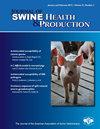种猪群每周猪繁殖和呼吸综合征病毒暴露与随后的病毒脱落和苗圃死亡率之间的关系
IF 0.7
4区 农林科学
Q3 Agricultural and Biological Sciences
引用次数: 4
摘要
目的:通过定量逆转录聚合酶链反应(qRT-PCR)对猪繁殖与呼吸综合征病毒(PRRSV)RNA进行处理液(PF)检测,描述每周繁殖群状态与随后的病毒脱落和育婴期累积死亡率的关系。材料和方法:根据PF中PRRSV的检测,将新生仔猪的每周队列(n=121)分为PRRSV暴露组:低(定量周期[Cq]≤27)、中(27本文章由计算机程序翻译,如有差异,请以英文原文为准。
Relationship between weekly porcine reproductive and respiratory syndrome virus exposure in breeding herds and subsequent viral shedding and mortality in the nursery
Objective: Describe the relationship of weekly breeding herd status based on processing fluid (PF) testing for porcine reproductive and respiratory syndrome virus (PRRSV) RNA by quantitative reverse transcriptase-polymerase chain reaction (qRT-PCR) on subsequent viral shedding and cumulative mortality during the nursery phase. Materials and methods: Weekly cohorts (n = 121) of newborn piglets were classified into PRRSV exposure groups according to PRRSV detection in PF: low (quantification cycles [Cq] ≤ 27), medium (27 < Cq ≤ 34), high (34 < Cq ≤ 37), and negative (Cq > 37). At 6 weeks of age, oral fluids (OF) were collected from a subset of 41 cohorts, tested by qRT-PCR, and results used to classify the nursery shedding status into the same aforementioned categories. Cumulative nursery mortality was recorded for all 121 cohorts and compared between the different PRRSV exposure groups. Test agreement was assessed between PF and OF results of 41 cohorts. Moreover, the effect of 4:1 OF pooling on the probability of testing qRT-PCR-positive was evaluated. Results: The nursery mortality for low Cq cohorts was 3.40 percentage points (range, 3.28-3.99) higher than other exposure groups. Overall, Cq values were higher in PF than in OF samples, and fair agreement (κ = 0.2398) between PF and OF was encountered. Compared to individual samples, 4:1 OF pooling resulted in 100% specificity and 76.92% sensitivity. Implications: Weekly PF testing for PRRSV allowed for exposure group classification for each pig batch produced, which was a good predictor of subsequent cumulative nursery mortality.
求助全文
通过发布文献求助,成功后即可免费获取论文全文。
去求助
来源期刊
CiteScore
1.80
自引率
0.00%
发文量
29
审稿时长
>36 weeks
期刊介绍:
The Journal of Swine Health & Production (JSHAP) is an open-access and peer-reviewed journal published by the American Association of Swine Veterinarians (AASV) since 1993. The aim of the journal is the timely publication of peer-reviewed papers with a scope that encompasses the many domains of applied swine health and production, including the diagnosis, treatment, management, prevention and eradication of swine diseases, welfare & behavior, nutrition, public health, epidemiology, food safety, biosecurity, pharmaceuticals, antimicrobial use and resistance, reproduction, growth, systems flow, economics, and facility design. The journal provides a platform for researchers, veterinary practitioners, academics, and students to share their work with an international audience. The journal publishes information that contains an applied and practical focus and presents scientific information that is accessible to the busy veterinary practitioner as well as to the research and academic community. Hence, manuscripts with an applied focus are considered for publication, and the journal publishes original research, brief communications, case reports/series, literature reviews, commentaries, diagnostic notes, production tools, and practice tips. All manuscripts submitted to the Journal of Swine Health & Production are peer-reviewed.

 求助内容:
求助内容: 应助结果提醒方式:
应助结果提醒方式:


